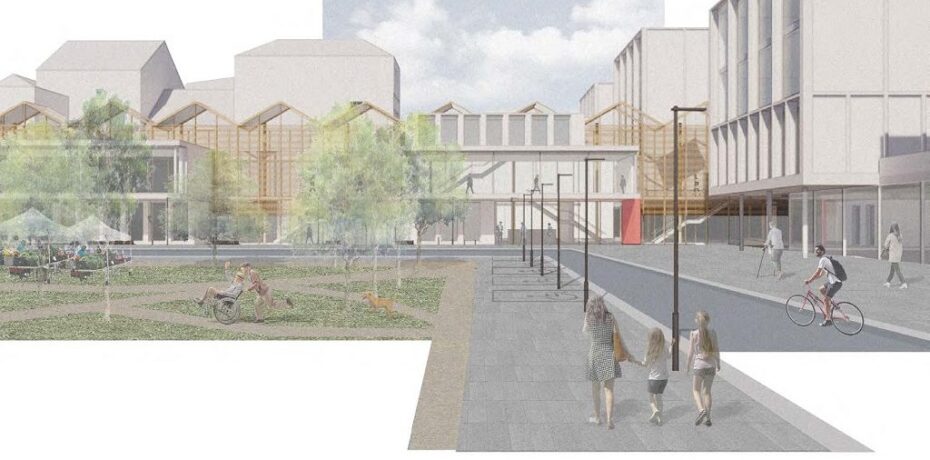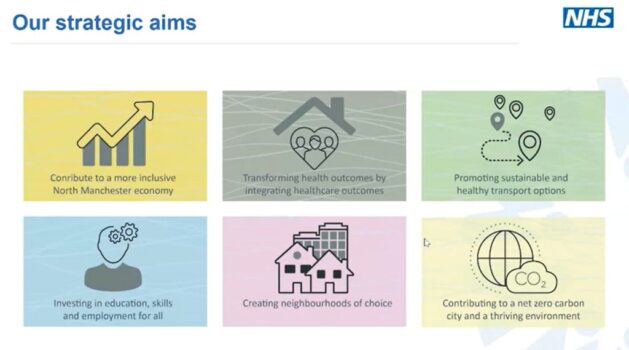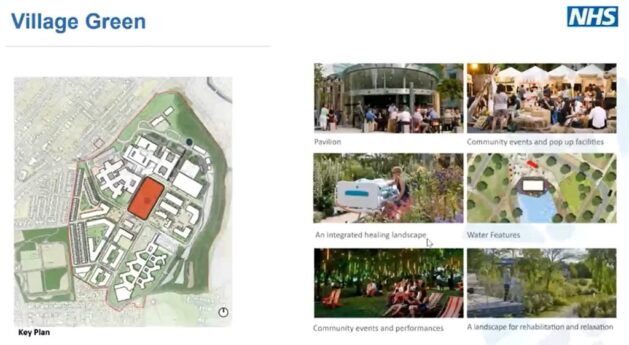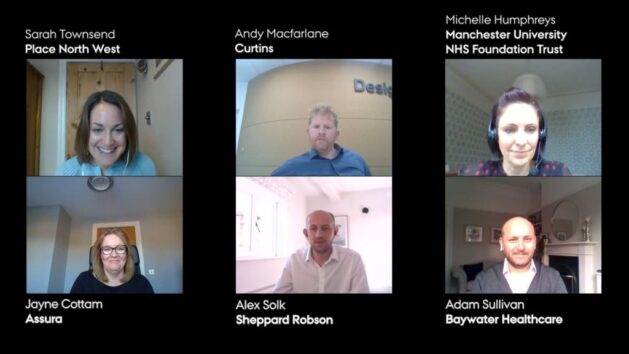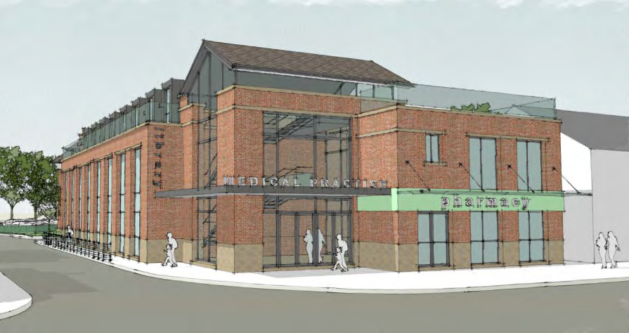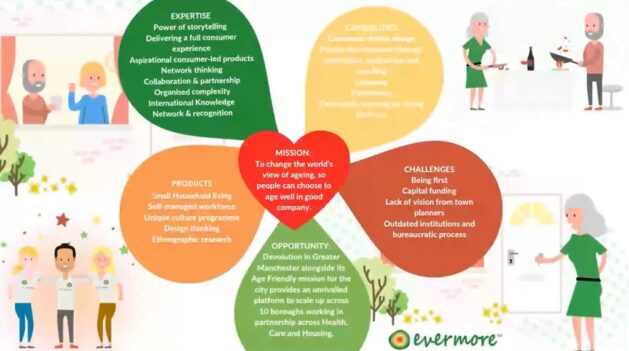Event Summary
Healthcare + Senior Living | Time for change
Property professionals discussed what needs to change to make health centres and senior living developments fit for the future, amid the twin challenges of an ageing population and the ongoing health crisis.
Work to create a healthy living-focused neighbourhood around North Manchester General Hospital in Crumpsall, as well as embedding flexibility into healthcare schemes to keep pace with shifting trends, were among the topics discussed by panellists at the latest Place North West event.
Healthcare + Senior Living was hosted by Place North West editor Sarah Townsend and sponsored by Sheppard Robson, SI Sealy, DAC Beachcroft, OakNorth Bank, Clearfibre and Curtins.
A full video recording of the event is available to watch here.
Presentation – Creating a healthy community in North Manchester
Michelle Humphreys, director of strategic projects at Manchester University NHS Foundation Trust, gave an overview of the planned £600m project to create a mixed-use, health-focused community and a new hospital at the 64-acre North Manchester General Hospital site in Crumpsall.
The trust, its joint venture partner Bruntwood Works and architect Sheppard Robson, are working together to redevelop the hospital’s estate, 70% of which is “in desperate need of repair”, according to Humphreys.
The project falls under the Government’s £3.7bn Health Infrastructure Plan, a strategy to upgrade the country’s hospital estate, and will act as the centrepiece of the council and trust’s wider ambitions to revitalise a deprived community and improve access to healthcare services to those who live in the surrounding area.
“As someone who has worked in regeneration and seen major regeneration in Hulme, East Manchester, Wythenshawe and Moss Side, there is a general consensus that we need to focus on North Manchester going forward,” Humphreys said.
While the regeneration of East Manchester was driven by sport, the strategy behind North Manchester’s revival would be underpinned by health, she explained – there are major concerns over the general wellbeing of communities in this part of the city, with issues rife including obesity, alcoholism and cardiovascular disease.
“[The project] is not just about the hospital but the wider health landscape. Whatever we do here we want the local community to benefit from,” she added.
A strategic regeneration framework that will guide the project is currently out for consultation and features five main pillars.
- Healthcare Hub – featuring a replacement acute hospital and modern mental health hospital, to anchor the campus
- Wellbeing Hub – to enable the delivery of modern, integrated community health, care and wellbeing services, with a single building for mixed service provision, meeting spaces and a café
- Education Hub – a centre to provide staff training for employees of the hospital and community health and wellbeing hub, and to generate employment opportunities for future local residents
- Healthy Neighbourhood Hub – up to 500 homes providing key worker accommodation, social housing, step-down care and extra care, as well as commercial space for local SMEs
- Village Green – comprising high-quality outdoor space, acting as a focal point for the campus with green spaces and water features, for staff and local residents to use for meetings, exercise and relaxation
Panel one – seizing opportunities and influencing trends
Michelle Humphreys – director of strategic projects, Manchester University NHS Foundation Trust
Jayne Cottam – chief financial officer, Assura
Alex Solk – partner and head of healthcare, Sheppard Robson
Andy Macfarlane – director, Curtins
Adam Sullivan – chief executive, Baywater Healthcare
Humphreys said that embedding flexibility into the redevelopment or construction of healthcare facilities is vital due to constantly changing demands.
“The cost of changing old buildings is massive, we really have to have an eye on the cost of repurposing in the future,” she said.
Solk agreed, adding that the prospect of using modern methods of construction is “exciting” as it could help speed up the process of delivering large-scale healthcare projects.
Despite hospitals being “perhaps the most difficult” type of development when it comes to the pursuit of net-zero carbon due to their high energy demand, Solk said the sector should not “shy away” from the challenge. He added that the sector should create buildings “able to switch between energy sources when it becomes more economically viable to do so”.
Cottam said that Assura, whose investment portfolio includes more than 600 healthcare centres across the UK, is taking a more “hands-off” approach to development projects due to the strain the NHS is under at present.
She added that, due to the current retail climate, there are likely to be increasing opportunities for repurposing town centre units into health centres and that Assura had recently issued a £300m bond to help fund its pipeline.
Macfarlane said the Covid-19 pandemic has “provoked an unprecedented rate of change” in healthcare and added that the response of designers to this change is crucial to the sector’s future success.
Like Solk, Macfarlane said using modern methods of construction would be key in terms of “driving innovation and disruption”.
He said: “MMC enables us to limit construction on site, which eases pressures on existing infrastructure like parking as well as noise, dust and vibration. That approach is going to be fundamental because it tackles the issue of flexibility as well.”
Sullivan, whose firm is a registered NHS provider and has supplied oxygen and respiratory equipment to hospitals and health centres throughout the pandemic, said that hospital trusts needed to consider the country’s ageing population and look to diversify their estates to contend with the challenge of people living longer.
Another option for easing the strain on the NHS is the concept of ‘virtual wards’ – whereby patients’ at-home care is managed digitally, freeing up beds for those who need them most, Sullivan said.
“It has been a key provision as part of the pandemic but I think it is here to stay. It is a way of migrating people away from the hospital setting into the community.”
Presentation two – changing the way we think about provision for the elderly
“Now is the time to make all the changes we need because everything is broken,” said Sara McKee, founder and market innovation director of later life consultancy Evermore Wellbeing.
McKee said she believes there needs to be a fundamental shift in the way accommodation for the elderly is provided, suggesting that, as people are now living longer, the needs of the group traditionally labelled as “elderly” are becoming more diverse. “We are talking about potentially three or four, or five decades of age here,” she said.
Post-retirement, people want to live in well-connected communities that are conducive to social interaction and allow residents to be “part of the action”, she noted.
“There is currently a disconnect between what the market wants and what is being developed.
“We have got to recognise that development needs to happen in partnership with prospective tenants and think about how to successfully connect them to existing communities,” McKee said.
Panel two – A shift in senior living philosophy
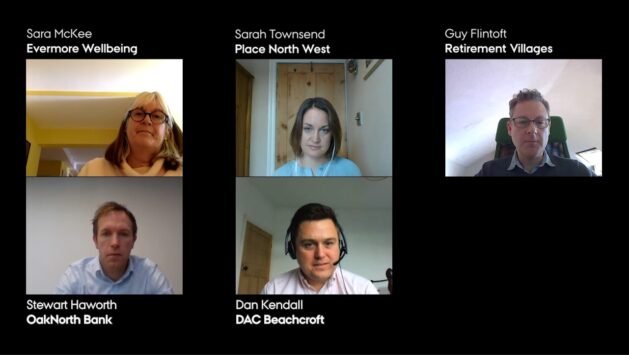
Sara McKee – founder and market innovation director, Evermore Wellbeing
Dan Kendall – residential development partner, DAC Beachcroft
Stewart Haworth – director of debt finance, OakNorth Bank
Guy Flintoft – planning director, Retirement Villages
McKee said it is often challenging to get buy-in from councils and investors for projects that push the envelope. “It is difficult when it is the first project of its kind to get funders and planning officers to take the leap. The first one is really difficult.”
The proposed Academy for Living Well in Edgeley – part of the planned redevelopment of St Thomas’ hospital site in Stockport – is one such project. It would feature a 70-bed care facility and 68 affordable homes. McKee described Stockport Council as “forward-thinking” in its approach to the scheme and its willingness to veer away from a more traditional model of senior living accommodation.
“We are still consumers and if you create a naff product people won’t buy it. We have got to be more consumer-facing in what we offer. We should make it about investing in experience rather than beds,” she added.
Kendall predicted that the senior living market would become “increasingly fragmented” in the coming years.
At present, the market is aimed at people aged 55 and over, something Kendall thinks will need to be rethought as people live and work longer. “If you tried to push a product designed to be suitable for people aged 18 to 48 you would question that approach. It’s a long period of time and people change,” he said.
He added that the sector is healthy at present, with a strong pipeline of projects compared to other property markets including retail and student accommodation, and said he envisages large build-to-rent developers taking an interest in the sector in future.
“I can see a situation where the BTR model starts to become appropriate for the lower end of the senior living bracket,” he said.
Haworth noted that the care home sector had suffered reputationally during the pandemic, and that from an investment point of view, care homes are more susceptible to a decline in occupancy levels and therefore require an “an economy of scale” to operate and “weather the storms of Covid”.
However, he agreed with Kendall that the sector’s outlook does still remain strong as demand continues to significantly outweigh supply. Funding is readily available for developers with a track record for delivery, he added.
In particular, the number of people suffering from dementia is increasing and therefore the need for more purpose-built accommodation to cater for this health issue is growing, Harworth said.
Flintoft agreed with much of McKee’s vision for the future of senior living accommodation, specifically that linking developments with existing communities is key.
One project that Retirement Villages is developing on the outskirts of Chester features a mobility hub and a park and ride, elements that “will enable people to live connected lives”, Flintoft said.
“People don’t want to retire from life in older age but actually see rightsizing their accommodation as a way of continuing to live their lives – that might mean carrying on working and it certainly doesn’t mean withdrawing from society,” he added.
Flintoft conceded that it would be difficult to broaden the appeal of Retirement Villages’ product beyond those in their mid-to-late seventies but said it was the firm’s responsibility to “create the backdrop to really active communities”. There is still an opportunity for a forward-thinking approach to more traditional retirement developments.


